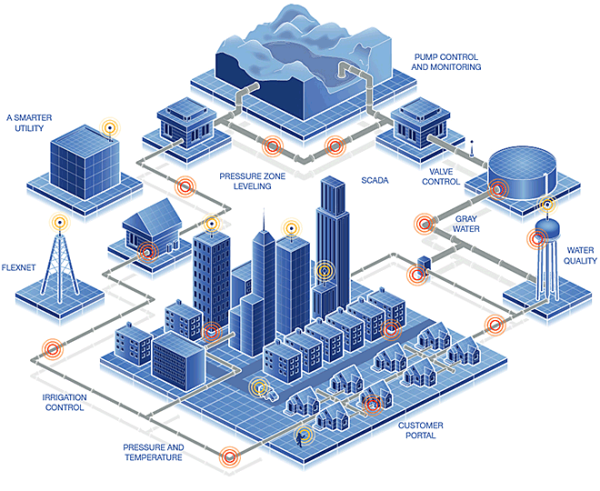Ultrasonic Metering - Overview
Mechanical meters have been used in the water industry for more than 150 years In recent years, a number of electronic metering technologies have emerged One of these advancements, the ultrasonic flow meter, was initially introduced in the early 1960s for industrial applications
Historically used for custody transfer involving natural gas and hydrocarbons, ultrasonic meters are now found in a wide range of applications encompassing dirty liquids, chemicals, and liquids with entrained particles More recent applications include steam and clean water
To date, water utilities have used ultrasonic meters primarily for large volume applications including raw water, water treatment and water custody transfer Ultrasonic meters have gained acceptance in large metering applications due to several advantages over traditional measurement technologies:
- Wide measuring range or turndown
- High accuracy sustained over the meter’s life
- High repeatability
- No moving parts to wear out or to generate noise
- Minimal intrusion in the flow stream
- Negligible pressure drop
- Generally unaffected by particles in the water
- Bidirectional by design
- Minimal maintenance
In general, these same advantages apply to small ultrasonic water meters when compared to positive displacement meters However, in the past, using ultrasonic technology for small applications was viewed as impractical and/or cost-prohibitive
Today’s technological advancements make the use of ultrasonic technology feasible for small metering applications In particular,improved high-speed digital signal processing, advanced piezoceramic transducers and sophisticated computer technology make ultrasonic flow meters a viable, cost-effective option.

Historically used for custody transfer involving natural gas and hydrocarbons, ultrasonic meters are now found in a wide range of applications encompassing dirty liquids, chemicals, and liquids with entrained particles More recent applications include steam and clean water
To date, water utilities have used ultrasonic meters primarily for large volume applications including raw water, water treatment and water custody transfer Ultrasonic meters have gained acceptance in large metering applications due to several advantages over traditional measurement technologies:
- Wide measuring range or turndown
- High accuracy sustained over the meter’s life
- High repeatability
- No moving parts to wear out or to generate noise
- Minimal intrusion in the flow stream
- Negligible pressure drop
- Generally unaffected by particles in the water
- Bidirectional by design
- Minimal maintenance
In general, these same advantages apply to small ultrasonic water meters when compared to positive displacement meters However, in the past, using ultrasonic technology for small applications was viewed as impractical and/or cost-prohibitive
Today’s technological advancements make the use of ultrasonic technology feasible for small metering applications In particular,improved high-speed digital signal processing, advanced piezoceramic transducers and sophisticated computer technology make ultrasonic flow meters a viable, cost-effective option.




评论
发表评论